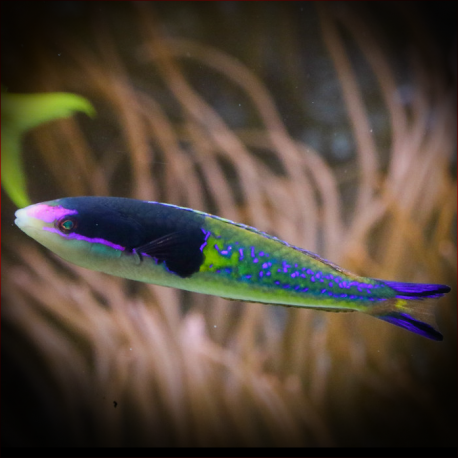More info
Datasheet
| Minimum Tank Size | 500 litres / 132.09 US gallons |
| Maximum Size | 9.0cm / 3.54inches |
| Reef Compatible | Reef safe with caution |
| Temperament | Mostly peaceful but might be aggressive towards similar species |
| Temperature | 22.2°C / 71.96°F - 25.6°C / 78.08°F |
| Specific Gravity | 1.020-1.025 |
| Carbonate Hardness | 8-12 |
| pH | 8.1-8.4 |
General Description
Pseudojuloides Severnsi, also known as Severns' Wrasse, is a delicate species belonging to the Labridae family, specifically Labridae-Pseudojuloides. These Pencil Wrasses are visually appealing but can be challenging to maintain long-term due to difficulties in providing adequate nutrition, often resulting in malnutrition and premature death. They are typically found in the East Indian Ocean, specifically in Indonesia, and have been recorded in regions like Sri Lanka, the Ryukyu Islands, and Indonesia in the Indo-West Pacific.
Aquarium Suitability
Severns' Wrasse, while captivating, requires a high level of experience, preparation, and meticulous care from aquarists. These fish are not recommended for beginners as they have specific demands that may be hard to meet. They are known to be sensitive during transportation and acclimatization to aquarium conditions. Moreover, they necessitate a well-established aquarium with a substantial population of microscopic organisms such as copepods and amphipods for foraging.
Demands, Care, and Hardiness
Due to their delicate nature, Severns' Wrasse demands a strict diet regimen with frequent feedings multiple times a day. Their diet should consist of small crustaceans like Krill, Mysis, and Artemia, along with zooplankton such as Cyclops and pods. Maintaining a healthy population of these vital organisms in the tank is crucial for the well-being of the wrasse. Additionally, they require a minimum tank size of 500 liters and a deep sandy substrate of at least 5 cm to mimic their natural behavior of burrowing for shelter and sleep.
Reef Suitability
While Severns' Wrasse is considered reef-compatible with caution, their temperament is mostly peaceful but can exhibit aggression towards similar species. It is essential to monitor their behavior closely, especially when housed in reef environments with other marine inhabitants.
Aquarium Setup
Creating a suitable habitat for Severns' Wrasse involves setting up a well-established aquarium with ample hiding spots within the deep sandy substrate for burrowing. As these fish tend to bury themselves at night or when feeling threatened, providing adequate shelter is essential. Maintaining stable water conditions with a pH ranging from 8.1 to 8.4, a specific gravity between 1.020 and 1.025, and a temperature range of 22.2-25.6 degrees Celsius is imperative for their health and well-being.
Behaviour
Severns' Wrasse is known to live in pairs, typically consisting of a male and a female. They exhibit interesting behaviors such as changing gender from female to male when necessary. Additionally, these wrasses might leap out of open aquariums, highlighting the need for secure tank covers to prevent escapes.
Feeding and Diet
Feeding Severns' Wrasse a diverse diet comprising small crustaceans like Krill and Artemia, as well as zooplankton such as Cyclops, is essential for their nutritional requirements. Their diet should be supplemented multiple times a day to ensure they receive an adequate intake of essential nutrients.
Habitat and Distribution
In the wild, Pseudojuloides Severnsi inhabits regions like the East Indian Ocean and Indonesia, with sightings reported in areas like Sri Lanka and the Ryukyu Islands in the Indo-West Pacific. Their natural habitat includes sandy substrates where they can burrow and seek refuge, emphasizing the importance of replicating similar conditions in the aquarium for their well-being.

